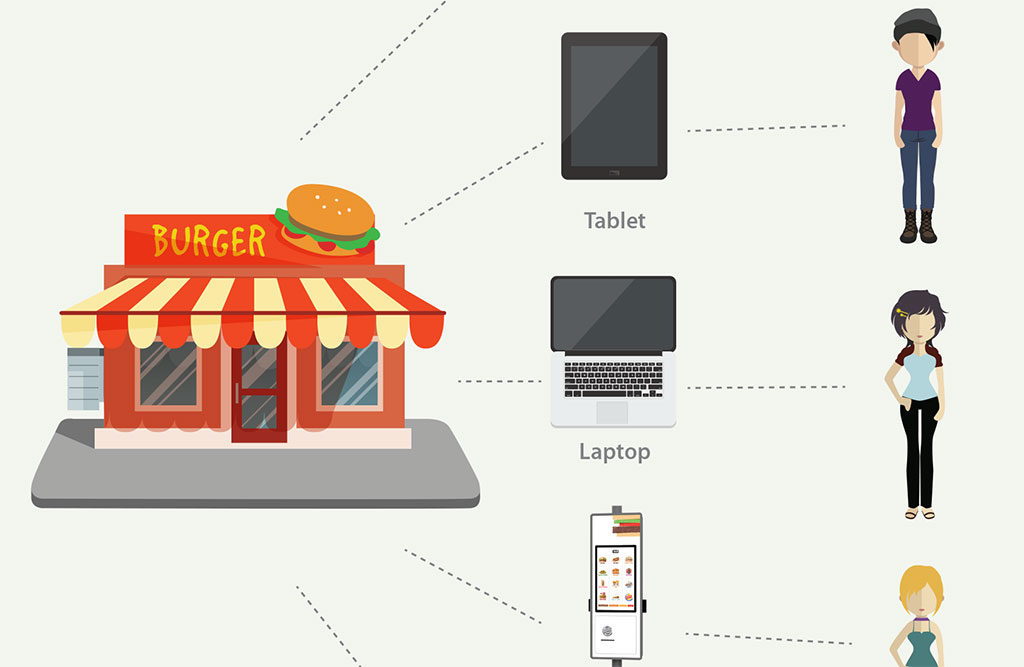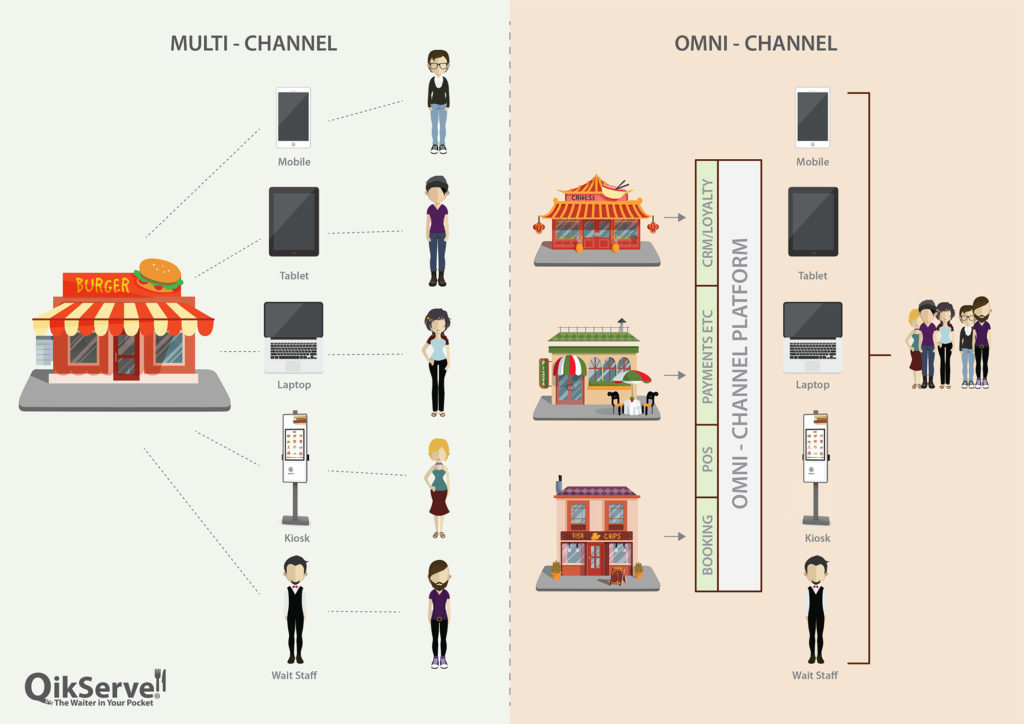You can’t go to any restaurant tech trade show or conference or read any hospitality resource nowadays without being bombarded with the words ‘omni-channel’ or ‘multi-channel’ guest experience. Its overuse by tech suppliers offering an all-singing, all-dancing solution, as well as the media keen to promote an impressive, progressive vision of the industry has, understandably, led to confusion as to what omni-channel and multi-channel really mean, not just for the consumer, but to operators too.
So what is omni-channel? How is it different to multi-channel? Have they just become lame buzz words pedalled by companies keen to impress or do they offer true differentiation in the overcrowded marketplace of guest-facing self-service offerings? Here we take a decisive look at what it really means to offer a genuine omni-channel experience and how a tech supplier you might be thinking of appointing should back up their claims of such capabilities.
Omni-channel vs. multi-channel
Many people use the words omni-channel and multi-channel interchangeably but there is a definite and important difference between the two. At QikServe, we see multi-channel as the different physical ways consumers and operators can interact, for example, through web, mobile, human server, tablet, self-service kiosk etc. With multi-channel, the customer journey is seen as a single, distinct experience defined by the channel they have chosen to use. For example, the guest checks-in via mobile, orders via mobile and pays via mobile. If a restaurant offers mobile, web and wait-staff service, they could be considered multi-channel, but not omni-channel. The key difference between the two?
Integration.
With omni-channel, you can mix and match they ways you choose to interact with a brand and, importantly, maintain the context between each channel in real time. So as a consumer, I might be sitting in my house, at my desk and choose to search for a restaurant then browse their menu on my laptop. I walk through to the kitchen and ask my husband what he wants to eat and as he decides, I start ordering the meal using my mobile. As I have to pick up my dry-cleaning and kids in town, I decide to also pick up my food order. When I arrive, the restaurant in packed and in full lunch-hour rush so I pay using their in-store self-service kiosk and head straight to the express line to pick-up my meal. I immediately receive a mobile alert offering a discount on my next order.
False advertising
When it comes to claims of ‘omni-channel self-service solutions’ by tech companies, we’ve come across a surprising number of mistruths. Of course businesses often embellish their capabilities when it comes to selling but some of these claims are optimistic at best and downright fiction at worst. And when operators look to tech suppliers to develop often expensive technologies with them, it can be a costly mistake to realise only too late that what they’re claiming to offer isn’t in fact the fully integrated, truly omni-channel solution they were after.
So what is wrong with the way people talk about their omni-channel capabilities today? By opting for a solution that offers order and payment through a specific channel but offers no form of integration either with the point of sale (POS), other channels or the CRM system for example, you leave yourself open to not only a fragmented, inefficient operational nightmare but you’re also letting your customer walk into a disjointed, often confusing guest experience.
One example we often come across is companies claiming to offer mobile order and payment but actually it’s just a responsive website available on mobile rather than an experience designed specifically for smartphones such as a dedicated mobile website or native app. Many aspects of both the user interface and the context within which a customer would use mobile on-the-go are very different compared to a desktop web experience so forcing a web peg into a mobile hole doesn’t do justice to your brand experience.
Some issues you might face when opting for a non-integrated multi-channel, but not omni-channel, solution include:
- Order error. If your web ordering isn’t synched with mobile ordering through the POS for example, multiple orders or a pile up of wrong orders can quickly create chaos for both front and back of house.
- Orphan orders. Operators need to be able to deal with orders of dubious status, for example, those started in one channel but completed in another or orders that haven’t been paid for yet. If your systems aren’t talking to each other, dealing with this issue gets tricky.
- Poor customer experience. Guests nowadays not only expect to be able to interact with you through mobile but they expect a seamless experience if they decide to switch between mobile, tablet or wait staff for example. If there isn’t a centralised way of managing information from different channels, databases and systems, the guest experience will suffer and so in turn will your profits.
- Brand damage. The fallout from an inconvenient guest experience full of friction and confusion? A whole heap of brand damage. Guests aren’t shy of writing a blistering review thanks to easily accessible apps like TripAdvisor. And when bad news travels twice as far and twice as fast as good news, you better be sure your customer experience is memorable for all the right reasons.
- Staff confusion. Your employees have to deal with a lot. Fussy, difficult customers, often unsocial working hours and let’s face it, not the best pay. So why throw in another layer of frustration with unintegrated self-service? If a guest starts an order by mobile, it’s important your staff can see exactly what they’ve ordered on the POS as well as if they’ve paid and the ability to add or change that order through the POS itself.
- Walk-outs. Directly related to the previous point, you need to make sure your staff know which tables have paid per section to avoid either an embarrassing situation with the guest or worse, loss of revenues from cases of ‘dine & dash’.
- Lack-lustre loyalty. When we discuss poor customer experience due to back end systems not speaking to each other, we don’t just mean for run-of-the-mill interactions such as browsing the menu, ordering and paying. It also extends to deeper relationships with your customers such as marketing and loyalty efforts. For example, customers expect to earn their loyalty points regardless of whether they’ve ordered their coffee in person or through your mobile app.
- Customer service costs. Not only could a ropey self-service solution fail to drive revenues for you, it may even cost you money. The price of dealing with customer services issues and fixing any inter-system discrepancies is costly work.
Bone fide omni-channel spotting
So when wading through the sea of tech suppliers, how do you sort the integrated from the non-integrated? The hyperbole from the truth and the buzz-words from a genuine omni-channel solution? Here’s what you can do:
Ask about integration. Integration between your channels (mobile, kiosk etc) and back end systems (POS, CRM etc) is key, which is why you need a platform approach to unify and maintain context for the customer across channels and to keep it operationally efficient for you. Also, adjust your viewpoint. Rather than seeing channel technologies as separate solutions, you need a platform to bring them together so a single, real-time customer view can be presented, a transaction status is accurate in real time and a comprehensive customer profile of past behaviour can be seen.
Make sure you know what is being defined within the solution. For example, is the solution fully integrated into the POS or is the supplier just a partner of the POS provider? Does the company offer a mobile application, a white labelled application, an SDK or is it just a responsive website? At the end of the day, a company might be offering you the breadth of channel offerings but the devil is in the detail with multi-channel and the depth of back-end systems integration is where the power of omni-channel really comes into play.






